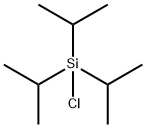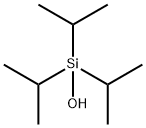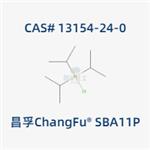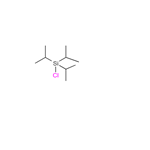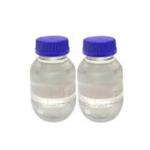Uses
Triisopropyl chlorosilane has found new applications as a blocking group. It has been utilized to prepare blocked derivatives of hydroxy compounds. Derivatization of substrates is accomplished efficiently in DMF containing a slight molar excess of imidazole. Blocked intermediates exhibited acidic hydrolytic stability intermediate between that of a Tert-butyldimethylchlorosilane and Tert-butyldiphenyl chlorosilane derivatives. Greater stability was obtained with Triisopropylchlorosilane under basic conditions.
Description
Triisopropyl chlorosilane is an important sterically hindered organosilicon protective agent, which is mainly used to protect various types of hydroxyl groups, especially in polyfunctional hydroxyl compounds, which can be selectively protected and deprotected. It is very important to synthesize nucleosides, nucleotides and carbohydrates. Triisopropylchlorosilane is a good hydroxyl protecting agent, and its silanization reaction is carried out in a slight excess of imidazole solution. The acid hydrolytic stability of the protected intermediate is between TBDMS and TBDPS and the alkaline hydrolytic stability is higher than the former two.
Chemical Properties
Triisopropylsilyl chloride is colorless clear liquid
Physical properties
bp 198 °C/739 mmHg; d 0.901 g cm?3.
Uses
Triisopropylsilyl chloride is used as a catalyst in the preparation of (silyloxy)cyclobutene derivatives. Also used in the addition of diethylzinc to N-diphenylphosphinoyl imines.
Uses
Chlorotriisopropylsilane is used as a silylating agent in neucleotide synthesis. It is used as an intermediate in the manufacture of chemical substances such as pharmaceuticals and in organic synthesis.
Uses
Triisopropylsilyl Chloride is a valuable reagent for hydroxy protecting group; formation of triisopropylsilyl ynol
ethers;N-protection of pyrroles; prevents chelation with
Grignard reagents, including but not limited to Formation of Silyl Ynol Ethers, N-Protection of Pyrroles, Prevention of Chelation in Grignard Reactions, Protection of Terminal Alkynes, Protection of Pyrroles, Indoles, and Other Heterocycles,Preparation of “Supersilylating” Agents,Reactions with Hydrazine, Reactions with Other Nucleophiles etc.
Preparation
There are two main methods for synthesizing triisopropyl chlorosilane. One is to use triisopropyl silane as a raw material, and hydrochloric acid and other reagents are used to chlorinate the hydrogen on the silicon. Another method uses silicon tetrachloride as raw material, and reacts with isopropyl lithium to obtain triisopropyl chlorosilane.
Application
Triisopropyl chlorosilane is mainly used as a basic intermediate in the synthesis of organic silicon materials and a blocking agent for silicone oil or silicone rubber. These triisopropylchlorosilanes can be used as raw materials for preparing functional silanes or silane coupling agents. In the reaction with organometallic compounds, the chlorine atoms of triisopropylchlorosilane are replaced by corresponding organic groups to form organochlorosilanes or organofunctional silanes.
Triisopropyl chlorosilane is mainly used in the production of aminosilane and methacryloxysilane, and can also be used as a rubber processing additive to couple inorganic fillers in various halogenated rubbers, such as neoprene rubber, chlorobutyl rubber , chlorosulfonated polyethylene and other halogenated rubbers. The existence of triisopropylchlorosilane can greatly improve various physical and mechanical properties of composites. Triisopropylchlorosilane can also be used to prepare antifungal and deodorant finishes with special bactericidal, deodorant, antistatic and surface-active properties.
